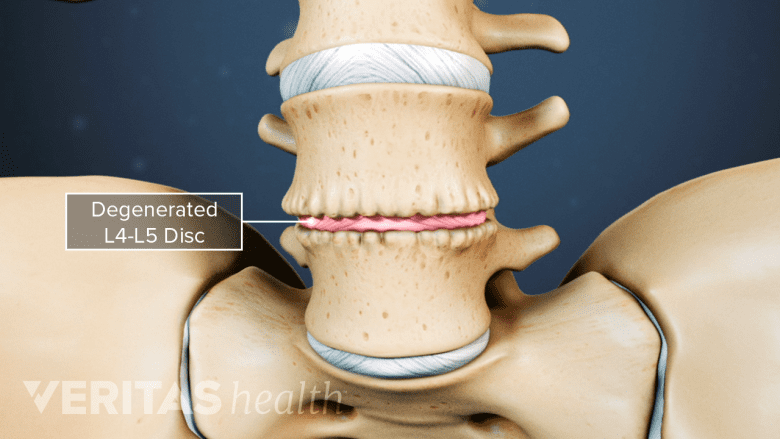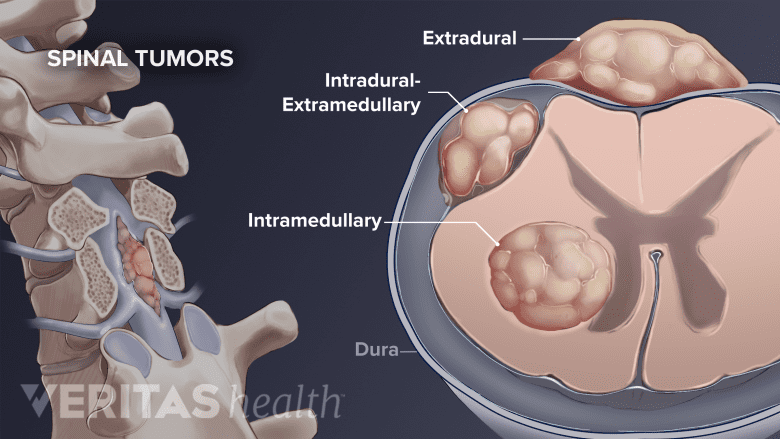Central canal stenosis typically occurs due to degenerative changes in the spine’s bones, joints, discs, and/or ligaments. Other potential causes of central canal stenosis include trauma, infections, and metabolic conditions that may affect the spine.
In This Article:
- Central Canal Stenosis
- Symptoms of Central Canal Stenosis
- Central Canal Stenosis Causes and Risk Factors
- Diagnosis of Central Canal Stenosis
- Nonsurgical Treatment of Central Canal Stenosis
- Surgery for Central Canal Stenosis
Common Causes of Central Canal Stenosis
Narrowing of vertebral discs from wear-and-tear is a cause for central canal stenosis.
The following conditions may commonly cause central canal stenosis:
- Age-related changes. Changes in the vertebrae such as from osteoarthritis may cause abnormal growth of bony tissues (bone spurs or osteophytes) impinging the spinal cord and/or spinal nerves. Sometimes, degenerated vertebrae may eventually slip over the vertebra below (spondylolisthesis), compressing the spinal cord. Research indicates osteoarthritis is the most common cause of stenosis in the lumbar spine.1Omidi-Kashani F, Hasankhani EG, Ashjazadeh A. Lumbar spinal stenosis: who should be fused? An updated review. Asian Spine J. 2014;8(4):521–530. doi:10.4184/asj.2014.8.4.521
- Instability. The abnormal movement of a vertebra forward (anterolisthesis) or backward (retrolisthesis) can cause compression of the spinal canal.
- Narrowing of the disc. Wear and tear of the vertebral discs may cause them to dry out and shrink. This condition may result in stenosis of the central spinal canal and other openings in the spine.
- Herniated disc. A herniated (bulging) disc that protrudes posteriorly (toward the spinal cord) or has a broad bulge may push against the spinal cord.
See What's a Herniated Disc, Pinched Nerve, Bulging Disc...?
- Traumatic injury. Trauma to the vertebrae may cause fracture, dislocation, or spondylolisthesis, causing stenosis of the spine.
- Ligament thickening. The ossification or thickening of the posterior longitudinal ligament and/or the ligamentum flavum may cause stenosis of the central canal.
- Postoperative problems. Past surgeries such as laminectomy or spinal fusion surgeries may cause the adjacent vertebrae to degenerate and result in structural changes leading to central canal stenosis.
It is also common for central canal stenosis to result from multiple structures degenerating within the spine at the same time.
Less Common Causes of Central Canal Stenosis
Rarely, central canal stenosis occurs due to spinal tumors.
Rarely, infections such as discitis may cause central canal stenosis. Discitis is the infection of the intervertebral disc caused by a bacteria or virus that travels to the spine through blood flow. Other rare causes include spinal tumors, cysts, and metabolic diseases such as Cushing’s syndrome and Paget’s disease, and scoliosis of the spine.
Risk Factors for Central Canal Stenosis
Some people may be at a higher risk of developing stenosis in the spine. A few risk factors include:
- Age. While people over 50 years of age are at an increased risk for stenosis, the condition may occur in younger individuals and be asymptomatic for many years.2Melancia JL, Francisco AF, Antunes JL. Spinal stenosis. In: Handbook of Clinical Neurology. Elsevier; 2014:541-549. doi:10.1016/b978-0-7020-4086-3.00035-7
- Male sex. Stenosis is more common in men than in women. However, more women have spinal stenosis resulting from spondylolisthesis (vertebra slipping forward).3Adams TL, Marchiori DM. Chapter 9: Arthritides. In: Marchiori DM. Clinical Imaging. Elsevier; 2014. doi:10.1016/c2009-0-42800-9
- Ethnicity. East Asians, particularly the Chinese, Japanese, and Korean populations are at a higher risk of ossification of the ligamentum flavum, which may cause central canal stenosis.4Garry JP. A Rare Case of Thoracic Spinal Stenosis in a White Male. Current Sports Medicine Reports. 2018;17(1):13-15. doi:10.1249/jsr.0000000000000440
The presence of these risk factors does not always cause stenosis of the spine, but merely increases the likelihood of its development.
While some people with spinal stenosis may not feel any symptoms, others with mild stenosis may experience significant pain. A trained medical professional can help diagnose the degree of stenosis and formulate a treatment plan. While physical examination and review of symptoms and signs can help diagnose spinal stenosis, doctors may order medical imaging tests to confirm the location and severity of stenosis in the spine.
- 1 Omidi-Kashani F, Hasankhani EG, Ashjazadeh A. Lumbar spinal stenosis: who should be fused? An updated review. Asian Spine J. 2014;8(4):521–530. doi:10.4184/asj.2014.8.4.521
- 2 Melancia JL, Francisco AF, Antunes JL. Spinal stenosis. In: Handbook of Clinical Neurology. Elsevier; 2014:541-549. doi:10.1016/b978-0-7020-4086-3.00035-7
- 3 Adams TL, Marchiori DM. Chapter 9: Arthritides. In: Marchiori DM. Clinical Imaging. Elsevier; 2014. doi:10.1016/c2009-0-42800-9
- 4 Garry JP. A Rare Case of Thoracic Spinal Stenosis in a White Male. Current Sports Medicine Reports. 2018;17(1):13-15. doi:10.1249/jsr.0000000000000440







